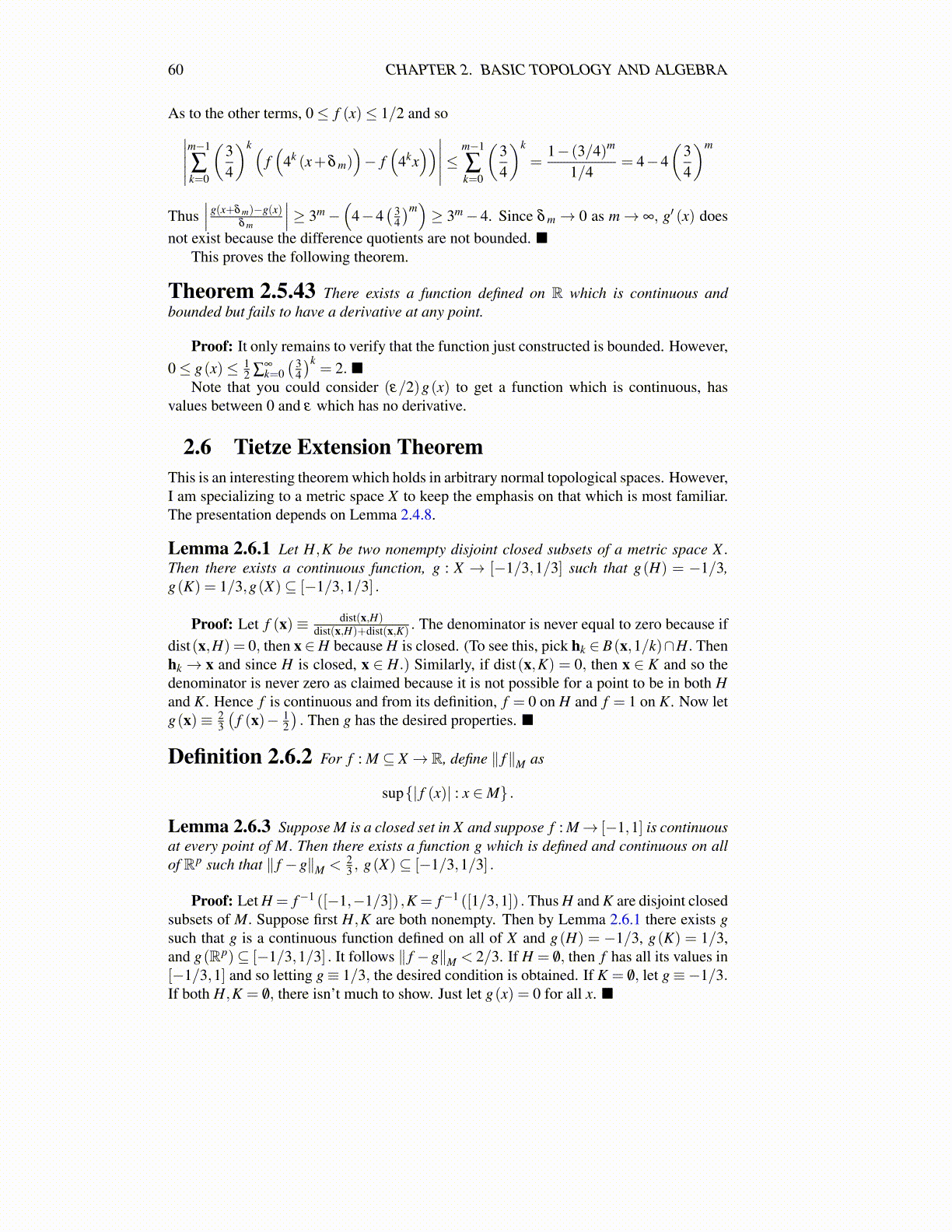
60 CHAPTER 2. BASIC TOPOLOGY AND ALGEBRA
As to the other terms, 0≤ f (x)≤ 1/2 and so∣∣∣∣∣m−1
∑k=0
(34
)k(f(
4k (x+δ m))− f
(4kx))∣∣∣∣∣≤ m−1
∑k=0
(34
)k
=1− (3/4)m
1/4= 4−4
(34
)m
Thus∣∣∣ g(x+δ m)−g(x)
δ m
∣∣∣ ≥ 3m−(
4−4( 3
4
)m)≥ 3m− 4. Since δ m→ 0 as m→ ∞, g′ (x) does
not exist because the difference quotients are not bounded. ■This proves the following theorem.
Theorem 2.5.43 There exists a function defined on R which is continuous andbounded but fails to have a derivative at any point.
Proof: It only remains to verify that the function just constructed is bounded. However,0≤ g(x)≤ 1
2 ∑∞k=0( 3
4
)k= 2. ■
Note that you could consider (ε/2)g(x) to get a function which is continuous, hasvalues between 0 and ε which has no derivative.
2.6 Tietze Extension TheoremThis is an interesting theorem which holds in arbitrary normal topological spaces. However,I am specializing to a metric space X to keep the emphasis on that which is most familiar.The presentation depends on Lemma 2.4.8.
Lemma 2.6.1 Let H,K be two nonempty disjoint closed subsets of a metric space X .Then there exists a continuous function, g : X → [−1/3,1/3] such that g(H) = −1/3,g(K) = 1/3,g(X)⊆ [−1/3,1/3] .
Proof: Let f (x)≡ dist(x,H)dist(x,H)+dist(x,K) . The denominator is never equal to zero because if
dist(x,H) = 0, then x∈H because H is closed. (To see this, pick hk ∈ B(x,1/k)∩H. Thenhk → x and since H is closed, x ∈ H.) Similarly, if dist(x,K) = 0, then x ∈ K and so thedenominator is never zero as claimed because it is not possible for a point to be in both Hand K. Hence f is continuous and from its definition, f = 0 on H and f = 1 on K. Now letg(x)≡ 2
3
(f (x)− 1
2
). Then g has the desired properties. ■
Definition 2.6.2 For f : M ⊆ X → R, define ∥ f∥M as
sup{| f (x)| : x ∈M} .
Lemma 2.6.3 Suppose M is a closed set in X and suppose f : M→ [−1,1] is continuousat every point of M. Then there exists a function g which is defined and continuous on allof Rp such that ∥ f −g∥M < 2
3 , g(X)⊆ [−1/3,1/3] .
Proof: Let H = f−1 ([−1,−1/3]) ,K = f−1 ([1/3,1]) . Thus H and K are disjoint closedsubsets of M. Suppose first H,K are both nonempty. Then by Lemma 2.6.1 there exists gsuch that g is a continuous function defined on all of X and g(H) = −1/3, g(K) = 1/3,and g(Rp)⊆ [−1/3,1/3] . It follows ∥ f −g∥M < 2/3. If H = /0, then f has all its values in[−1/3,1] and so letting g≡ 1/3, the desired condition is obtained. If K = /0, let g≡−1/3.If both H,K = /0, there isn’t much to show. Just let g(x) = 0 for all x. ■